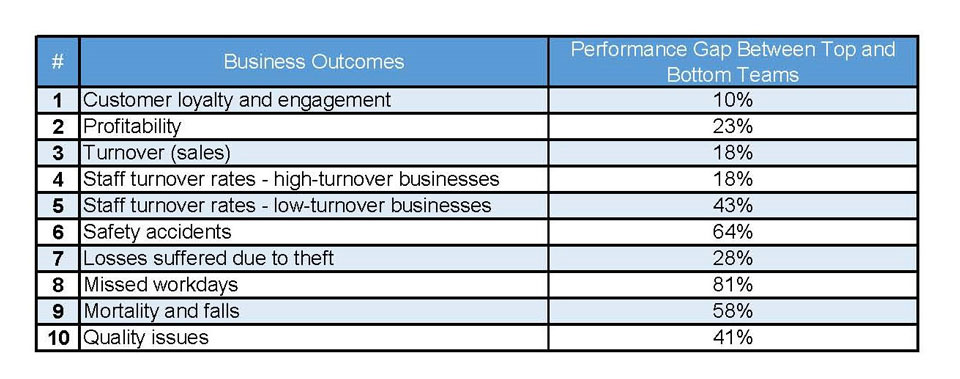Increased Productivity Starts with an Engaged Workforce

Unleashing the full potential of an organization lies not only in advanced technology or robust strategies but fundamentally in its people. Employee engagement is a concept that any business can embrace. To do so, however, involves a consistent commitment from the top to the bottom of the organizational structure.
Research shows employee engagement profoundly impacts individual and organizational performance, productivity, and profitability. Engaged employees who genuinely feel they can speak their minds and will be heard will likely stay with the organization longer, be more motivated and productive, and drive innovation. The connection is clear-cut, but leaders need to take specific steps to bolster engagement. It is indeed both a bottom-line issue and a personal one for each individual in the organization.
What does employee engagement look like today?
Today’s engaged employees demonstrate an ability to stay connected even when working from home, a shared workspace, a hybrid model, or the traditional five-days-a-week office setting. They embrace the concept of continuous learning, seeking opportunities to upskill and align themselves with a company’s objectives. Of course, it’s a two-way street where the top executives must foster a collaborative environment that makes people want to stay engaged. Motivated workers who are more willing to go the extra mile to make things right often translate that feeling to customers. It’s a win-win, internally and externally.
Organizations are healthier when they have open channels of communication that encourage feedback without recrimination and appreciate the two-way dialogue where employees feel they are an integral part of the decision-making process. Here’s an example. One reason Google was listed as a “best place to work” this year is because, according to an employee who works for the tech giant, “Over the past 3-4 years, Google has been making an important effort to become a more equitable, diverse, and inclusive place to work. It allows employees to express their opinions to help improve the company culture overall.”
A holistic approach where an employee’s mental, emotional, and physical well-being are supported can reduce burnout, leading to the better work-life balance employees seek. Truly engaged employees, whether blue- or white-collar, find purpose in their work. They also stay at the company longer and reduce costly turnover, including recruitment and training costs and lost productivity.
Back in the day: What employee engagement used to mean
In past generations, company loyalty often came without much thought to aligning one’s purpose with the organization’s vision. Instead, the goal was to stay with the company for several decades and then retire. Employees were considered engaged if they came in early and stayed late, with less emphasis on productivity and output quality. Because a higher level of productivity wasn’t overtly demanded and there was little motivation or incentive to learn new skills, do better work, and be more productive, those who were not inherent self-starters were often tempted to perform at the minimum level needed to stay employed.
Perhaps the biggest relic of what employee engagement used to be centered around hierarchical respect—where bosses were not to be questioned because they were in a higher position of authority. One study described standard hierarchy as the lowest form of respect possible. Today, the emphasis is on collaborative respect, where input and insight from all levels are recognized. Growth opportunities, continuous learning, and challenges that push the boundaries have eclipsed employee job security. Jim Whitehurst, the CEO of Red Hat, recommends three ways for leaders to earn respect: “Show passion for the purpose of your organization and constantly drive interest in it. Demonstrate confidence. Engage your people.” There is considerable room for improvement: A 2023 Gallup survey reveals just 31 percent of U.S. employees feel engaged, and 17 percent responded as “actively disengaged” (Figure 1).

Measuring employee engagement
Can the level of engagement be tracked with this approach to building and retaining a more motivated workforce? Here are some ways to collect and use that data to focus on improvement.
- Regular surveys. Use surveys to ask about job satisfaction, management relationships, and remuneration.
- Pulse surveys. Shorter, more frequent questionnaires can provide real-time insights into employee engagement levels.
- Employee Net Promoter Score. These are similar to the Net Promoter Score measurements used for customers. Use this assessment to determine how likely employees would be to recommend their companies to others.
- Focus groups. Focus groups can encourage dialogue by diving into specific issues. Employees may feel more encouraged to speak up when surrounded by peers.
- Participation rates. Use participation rates to track how often employees participate in company events or training and development programs. Determine if those programs need to be recalibrated based on this information and employee feedback.
- One-on-one and exit interviews. These interviews can provide insight into individual engagement levels and if someone leaves due to a lack of engagement.
While company executives may find some of this feedback surprising or even painful, it can be the basis for an improved action plan. Staff turnover rates, absenteeism, productivity benchmarks, and customer satisfaction feedback can also provide valuable clues as to the health of a company’s workforce. There is no one-size-fits-all approach; these measurements must be tailored to an organization’s size, culture, and industry sector. It is essential to recognize that as societal norms change, they will permeate the workplace and the employee mindset. This means engagement strategies must be adapted accordingly to stay relevant. Some of these mindset shifts may be more difficult for senior-level employees who are used to how they have operated for many years. Still, the more discerning managers will recognize the importance of adjusting management styles and employee engagement strategies.
Employee engagement benefits
The metrics have been analyzed, and tweaks have been made to employee engagement initiatives. Transformative results can include increased work effort, improved decision-making and problem-solving, more efficient resource utilization, reduced absenteeism, and a more collaborative synergy that can all help enhance the bottom line. These improvements reinforce an organization’s commitment to continue the investment in employee engagement. In this type of environment, employees may commit fewer errors, leading to improved quality output. At the same time, they may be more attentive on the job, reducing the number of workplace safety incidents. Employee engagement also leads to increased sales revenue, customer satisfaction, and brand loyalty. Operational costs can be optimized, staff turnover decreased, and collaborative innovation can lead to growth when employee engagement is high.
A Gallup/workhuman 2022 survey involving thousands of employees in the United States, Ireland, and the United Kingdom described the value of employee engagement, where senior management makes them feel more valued. When respondents are fully recognized for their contributions, 56 percent said they were less likely to look for other job opportunities, while 73 percent were less likely to be burned out on a regular basis and five times as likely to feel connected to the company culture. The survey also revealed that 73 percent of respondents said their organizations did not offer upper management any best practices training for employee recognition, and that it was not a major strategic priority.
A Gallup study revealed that the benefits of employee engagement have a dramatic impact on business performance in a number of areas. Companies with highly engaged employees experience significant performance advantages over their counterparts with disengaged teams (Figure 2). These differences are always important, the researchers state, but are especially critical during times of disruption such as during economic downturn.

The need for buy-in
Employee engagement will only be implemented and sustained effectively when decision-makers from all levels in the management structure are on board with the concept. In the United States, post-COVID, there are still more job openings than people willing to fill those positions; job seekers can seek out companies with a reputation for promoting employee engagement. Use data and case studies to present a compelling case to the leadership team that there are more effective methods to operate a business. Emphasize the importance of accepting feedback to reinforce trust and to ensure that the flow of two-way dialogue continues unimpeded. Provide disengaged managers with training in leadership, communication, and engagement strategies. Ensure that job roles clearly describe responsibilities and how these positions fit with the broader organizational goals. It is more challenging to provide feedback and foster engagement when employees aren’t sure of their roles or where they stand.
The drive for heightened employee engagement
In addition to senior leadership, other individuals and teams can reinforce employee engagement. Human resources (HR) can craft and roll out employee engagement initiatives. Encourage employees from various departments to join well-being or “culture committees,” to offer a more diverse perspective on engagement challenges and solutions. Communication, training, and development teams fueled by feedback and dialogue can be visible signs that the information is being put to practical use. When empowered employees take ownership of their roles, they make valuable real-time decisions and contribute new ideas regularly. That fosters a sense of trust and responsibility.
A long-term, consistent, and visible commitment to the concept must be demonstrated for employee engagement to work. Engagement isn’t a one-time initiative. It’s a continuous, evolving process shaped and modified based on feedback and other data. A holistic, top-down approach is critical to successful employee engagement; this cannot be a side project for the HR department. Comprehensive and authentic initiatives will resonate more effectively with an employee’s aspirations and needs.
Adapting to an ever-changing landscape is crucial. If the company employs remote or hybrid workers, fully engaging those off-site employees will require extra effort. It may, however, be the only way to retain valued personnel. When companies adopt decentralized work models, it is crucial that they emphasize building communities in virtual workspaces to ensure those employees feel connected and part of a cohesive unit. Artificial intelligence may play a significant role as it provides instant access to communication channels for more efficient collaboration with the home office and other employees.
Case studies
Forbes has recognized Salesforce for its focus on community engagement and a strong sense of purpose that has helped attract and retain talent. Feedback from their employees includes, “I’m particularly amazed at how genuine the leadership is. It is mind boggling in this day and age that leadership for a company this size is so professional, goal oriented, and cares… I hope and pray that Salesforce continues this company culture from the top down.” Other organizations recognized recently for leveraging employee engagement to bolster productivity and profitability include Southwest Airlines for nurturing camaraderie and DHL Express for recognizing employee achievements that have boosted morale, performance, and loyalty. Companies investing in the “employee experience” tend to outperform others financially and are often listed in Best Places to Work rankings.
Whether based on or off campus, Deloitte’s 2023 Global Human Capital Trends report calls it cocreating the relationship, where “organizations and workers will need to learn to navigate this new world together—cocreating new rules, new boundaries and a new relationship.” The Deloitte report contends that “workers today have more choices and influence than ever before—and are increasingly willing to use that newfound influence to shape the actions and agendas of their organization. Business leaders need to harness worker passion and energy to create mutual benefits for everyone.” A Harvard Business Review report addressed the concept of psychological safety, where employees seek out leaders they can talk to and be authentic around. Leadership starts by practicing what the study calls confident vulnerability, when leaders share their journeys and the obstacles they overcame while moving up the ladder.
While the Gallup State of the Global Workplace report finds that globally, employees are more engaged than ever, at the same time, they also feel more stress. In a June 2023 post, Gallup stated that employees worldwide who are not engaged at work (or are actively disengaged) represent a staggering $8.8 trillion in untapped “productivity opportunity” for global workplaces.
A call to action
In a post-pandemic era, with many still working from home or in a hybrid environment, a consistent and dedicated approach to improved employee engagement is more critical than ever. If leaders cannot keep on-site employees engaged and enthusiastic about their roles, engaging remote employees, whose link to the company mainly comes through their computer screens, is even trickier.
Employee engagement can be measured to demonstrate its benefits, including increased productivity and employee retention. By fostering an environment where employees are motivated, passionate, and emotionally invested, businesses can unlock remarkable productivity gains, superior performance, and improved profitability. For this concept to be successful, a long-term, consistent, and visible commitment to the idea must be demonstrated. Companies that invest in engaging their employees will reap the rewards.
Written by Michelle Austin.
Have you read?
Ranking: Richest Golfers in the World, 2023.
These Largest Cities Will Face Extreme Climate Change Threats.
These All-American Football Movies Inspired CEOs and Management Consultants The Most.
These Are Most Disliked Companies in America, 2023.
Report: Countries That Attract the Most International Migrants.
Add CEOWORLD magazine to your Google News feed.
Follow CEOWORLD magazine headlines on: Google News, LinkedIn, Twitter, and Facebook.
This report/news/ranking/statistics has been prepared only for general guidance on matters of interest and does not constitute professional advice. You should not act upon the information contained in this publication without obtaining specific professional advice. No representation or warranty (express or implied) is given as to the accuracy or completeness of the information contained in this publication, and, to the extent permitted by law, CEOWORLD magazine does not accept or assume any liability, responsibility or duty of care for any consequences of you or anyone else acting, or refraining to act, in reliance on the information contained in this publication or for any decision based on it.
Copyright 2024 The CEOWORLD magazine. All rights reserved. This material (and any extract from it) must not be copied, redistributed or placed on any website, without CEOWORLD magazine' prior written consent. For media queries, please contact: info@ceoworld.biz
SUBSCRIBE NEWSLETTER








